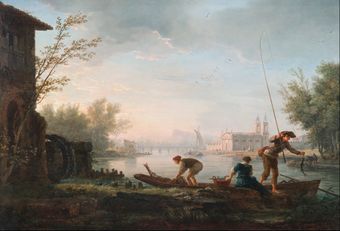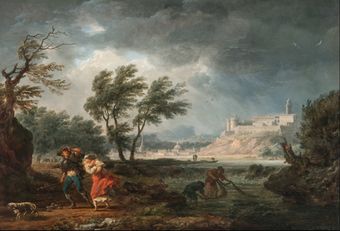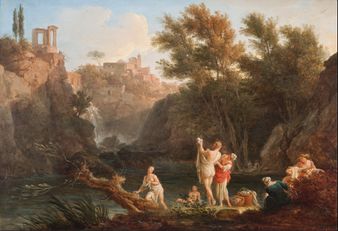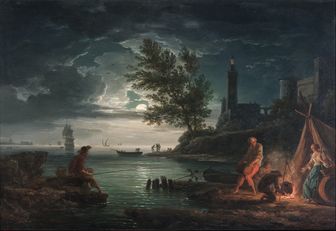أوقات اليوم الأربع (جوزيف ڤرنيه)
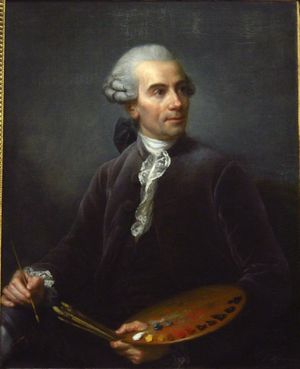
أوقات اليوم الأربع هي سلسلة من أربع لوحات تصور أوقات اليوم الأربع: الصباح، الظهيرة، المساء و الليل بريشة رسام المناظر الطبيعية الفرنسي كلود جوزيف ڤرنيه (1714–1789).[1][2][3][4] وقد رُسِموا في 1757 في پاريس، وهن محفوظات في معرض أستراليا الجنوبية للفنون، أدليد.[1][2][3][4] اللوحات تتألف من أربع مناظر منفصلة تصوّر الصباح والظهيرة والمساء والليل،[5] هي سلسلة رسمها عدد من فناني الفترة، منهم ڤرنيه وفيليپ جيمس دى لوثربورگ.[5]
. . . . . . . . . . . . . . . . . . . . . . . . . . . . . . . . . . . . . . . . . . . . . . . . . . . . . . . . . . . . . . . . . . . . . . . . . . . . . . . . . . . . . . . . . . . . . . . . . . . . . . . . . . . . . . . . . . . . . . . . . . . . . . . . . . . . . . . . . . . . . . . . . . . . . . . . . . . . . . . . . . . . . . . .
الفنان
Joseph Vernet was considered the leading French artist of his time in his genre, marine art and landscape painting. كلود جوزيف ڤرنيه come from a family of French painters: he was the son of a decorative painter, and his son أنطوان تشارلز أوراس ڤرنيه, called كارل ڤرنيه (1758–1836), and his grandson اوراس ڤرنيه (1789–1863) were known as military painters. Vernet lived in Italy for twenty years, from 1734 to 1753, where he had an atelier in Rome. His style was influenced by the Italian 17th-century painters Claude Lorrain and Salvator Rosa. His landscapes and especially seascapes were celebrated for their romantic qualities. Upon his return to France, a series of marine paintings were commissioned from him around 1753 by the French king Louis XV to depict a series of seaports, of which fifteen paintings were executed. This project lasted for about ten years, and until 1765 he traveled around the country painting seascapes around France, eventually abandoning the project unfinished.[6][7][8]
اللوحات
In the series of four paintings, the first depiction is entitled Morning. The painting shows a misty morning scene with fishermen with their boat. The second painting, entitled Midday depicts a sudden, unexpected storm. The painting Evening shows women bathing and washing their clothes. The final scene shows a rocky inlet, with fishermen drying their nets while others are gathered round a fire. The scenes depicted in these four paintings were Vernet's favourite scenes that he painted in different settings throughout his career.[9][10]
- أوقات اليوم الأربع
انظر أيضاً
الهامش
- ^ أ ب "Morning". www.artgallery.sa.gov.au. Retrieved 2 October 2018.
- ^ أ ب "Midday". www.artgallery.sa.gov.au. Retrieved 2 October 2018.
- ^ أ ب "Evening". www.artgallery.sa.gov.au. Retrieved 2 October 2018.
- ^ أ ب "Night". www.artgallery.sa.gov.au. Retrieved 2 October 2018.
- ^ أ ب Lochhead 1982, pp. 78–79.
- ^ "Biography and Works, Joseph Vernet". www.museothyssen.org. Retrieved 2015.
{{cite web}}: Check date values in:|accessdate=(help) - ^ "Encyclopædia Britannica, Joseph Vernet". www.archive.org. Retrieved 2015.
{{cite web}}: Check date values in:|accessdate=(help) - ^ "making_nature". arthistory.about.com. Retrieved 2015.
{{cite web}}: Check date values in:|accessdate=(help) - ^ "Claude Joseph Vernet". www.bbc.co.uk. Retrieved 2015.
{{cite web}}: Check date values in:|accessdate=(help) - ^ "National Trust Collections, Vernet". www.nationaltrustcollections.org.uk. Retrieved 2015.
{{cite web}}: Check date values in:|accessdate=(help)
مراجع
- Lochhead, Ian J. (1982). The Spectator and the Landscape in the Art Criticism of Diderot and His Contemporaries. Umi Research Press.
{{cite book}}: Invalid|ref=harv(help)
This article incorporates text from a publication now in the public domain: Chisholm, Hugh, ed. (1911). "Vernet". دائرة المعارف البريطانية. Vol. 27 (eleventh ed.). Cambridge University Press. p. 1030. {{cite encyclopedia}}: Cite has empty unknown parameter: |coauthors= (help)
